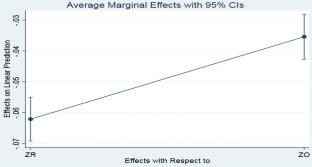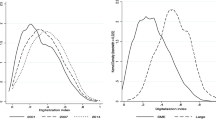Abstract
In the globalized world, factors, such as environmental regulations and outcomes, are interlinked with foreign direct investment and technological innovation. However, firm-level theories mostly treat them independently. We have filled the gap by carrying out empirical research with an integrated approach at the firm level. The theoretical framework is based on Porter’s hypothesis and the pollution haven hypothesis/pollution halo hypothesis. We collect the data from the center for monitoring Indian Economy Prowess IQ and the Ministry of Environment, Forest, and Climate Change. Using the modified Krugman specialization index, we find that Indian manufacturing firms are neither converging nor specialized in terms of technical progress. Estimating a z-score for environmental stringency, we interact that with the pollution loads of the firms. Our findings suggest that environmental regulation does not ensure a “win–win” situation for the producers, refuting Porter’s hypothesis. Rather, factors such as profit margin and R&D produce robust results across different models to induce the productivity of the firm. One of the concerning facts is older firms using vintage capital are detrimental to productivity enhancement, and there is evidence of layoff at the cost of increasing profits to improve the firm performance. Also, more dependence for export-intensive firms on material increases the cost and, thereby, reduces productivity. In addition, we apply a panel threshold regression model and conclude that there is evidence of a single threshold, and irrespective of the choice of technology foreign firms induces the energy intensity, confirming a pollution Haven hypothesis.
Graphical abstract





Similar content being viewed by others
Data availability
Enquiries about data availability should be directed to the authors.
Notes
Environment is considered to be a factor of production.
One of the threat perceptions is that the resource-rich countries are vulnerable to PHH, known as the resource curse hypothesis, although the evidence is mixed (Liang et al. 2023).
India imports a large volume of non-renewable resources despite a large volume of production, and this has been increasing over the years (Energy Statistics 2023). A substantial part of it is exported as it does not meet the environmental standard. As there is an excess demand for the same, they import it from the developed countries. A part of this import might be the surplus that does not meet environmental standards in those countries, and the laxity of regulations may induce the threat of both PH and PHH/PHaH.
To the best of our knowledge, this is the first empirical paper to integrate PH and PHH for Indian manufacturing firms.
Since PH incentivizes the firms with a “win–win” situation, the decision of the firm will be taken based on the possibility of the improvement of their outcome. Often this is measured in terms of total factor productivity (TFP).
In this paper, we are not interested in focusing on the narrow version because: i. The interest of the paper does not lie in validating this; and ii. there is an acute shortage of the data.
The list of the indicators will be discussed later. Input intensities refer to labor intensity, capital intensity, material intensity, and energy intensity.
Z = (Xit-Xt)/σit.
Intensities are not considered separately to omit the problem of correlation and multicollinearity problems as these variables are used while calculating the TFP.
We have not reported the green firms as it will be considered as base in the regression models.
There is a possibility of the existence of a nonlinearity; specifically, it may have an exponential effect. This may lead to the probabilistic measures to cross their bounds.
As a rule of thumb, we have tested for multicollinearity, stationarity, and cointegration. Since the independent variables have VIFs less than 10, they are found to be non-colinear. Besides, they are stationary in the first difference, and they are found to exhibit a long-term relationship due to the significant cointegration.
We have calculated the mean spending on R&D by domestic and foreign firms. It is seen that foreign firms are spending four to five times more on R&D than domestic firms.
We have tested the correlation of the dependent variable and the covariates. It exhibits that tax and profit are highly correlated (0.49), and hence, we keep both of them in separate regression and compare them. This was carried out for the unbalanced panel as well, but in that case, the correlation was less than 0.3.
References
Abid N, Ahmad F, Aftab J, Razzaq A (2023) A blessing or a burden? Assessing the impact of climate change mitigation efforts in Europe using quantile regression models. Energy Policy 178:113589
Al-Mulali U, Tang CF (2013) Investigating the validity of pollution haven hypothesis in the gulf cooperation council (GCC) countries. Energy Policy 60:813–819
Ambec S, Cohen MA, Elgie S, Lanoie P (2013) The Porter hypothesis at 20: Can environmental regulation enhance innovation and competitiveness? Rev Environ Econ Policy 7(1):2–22. https://doi.org/10.1093/reep/res016
Ashford, N. A. (1993). Understanding technological responses of industrial firms to environmental problems: Implications for government policy (chapter).
Bagchi P, Sahu SK (2020) Energy intensity, productivity and pollution loads:empirical evidence from manufacturing sector of India. Stud Microecon 8(2):194–211
Bagchi P, Sahu SK, Kumar A, Tan KH (2022) Analysis of carbon productivity for firms in the manufacturing sector of India. Technol Forecast Soc Chang 178:121606
Bradford DF, Fender RA, Shore SH, Wagner M (2005) The environmental Kuznets curve: exploring a fresh specification. Contrib Econ Anal Policy 4(1):1–28
Bramber T, Clark WR, Golder M (2006) Understanding interaction models: improving empirical analysis. Polit Anal 14(3):63–82
Brunnermeier SB, Cohen MA (2003) Determinants of environmental innovation in US manufacturing industries. J Environ Econ Manag 45(2):278–293
Bu M, Qiao Z, Liu B (2020) Voluntary environmental regulation and firm innovation in China. Econ Model 89:10–18
Chandrika R, Mahesh R, Tripathy N (2022) Is India a pollution haven? Evidence from cross-border mergers and acquisitions. J Clean Prod 376:134355
Cole MA (2004) Trade, the pollution haven hypothesis and the environmental Kuznets curve: examining the linkages. Ecol Econ 48(1):71–81
D’Agostino LM (2015) How MNEs respond to environmental regulation: integrating the Porter hypothesis and the pollution haven hypothesis. Economia Politica 32:245–269
Falkowska A (2020) The impact of environmental policy on location patterns in the waste management industry. Economia Politica 37(1):167–195
Ghosh A, Kayal P, Bagchi P (2024) Climate change and tourism: Assessing the nexus and climate-related disasters in diverse economies. J Clean Prod 443:141097. https://doi.org/10.1016/j.jclepro.2024.141097
M Greenstone, J A List, C Syverson. (2012). The effects of environmental regulation on the competitiveness of US manufacturing (No. w18392). National Bureau of Economic Research
Grossman GM, Krueger AB (1991) Environmental impacts of a North American free trade agreement. NBER Working Paper No. 3914. National Bureau of Economic Research.
Hansen BE (1996) Inference when a nuisance parameter is not identified under the null hypothesis. Econometrica 64(2):413. https://doi.org/10.2307/2171789
Hansen BE (1999) Threshold effects in non-dynamic panels: Estimation, testing, and inference. J Econ 93(2):345–368
Jaffe AB, Palmer K (1997) Environmental regulation and innovation: a panel data study. Rev Econ Stat 79(4):610–619
Kearsley A, Riddel M (2010) A further inquiry into the pollution Haven hypothesis and the environmental Kuznets curve. Ecol Econ 69(4):905–919
Kheder SB, Zugravu N (2012) Environmental regulation and French firms location abroad: an economic geography model in an international comparative study. Ecol Econ 77:48–61
Liang H, Shi C, Abid N, Yu Y (2023) Are digitalization and human development discarding the resource curse in emerging economies? Resour Policy 85:103844
Liu J, Qu J, Zhao K (2019) Is China’s development conforms to the environmental Kuznets curve hypothesis and the pollution haven hypothesis? J Clean Prod 234:787–796
Ma R, Abid N, Yang S, Ahmad F (2023) From crisis to resilience: strengthening climate action in OECD countries through environmental policy and energy transition. Environ Sci Pollut Res 30(54):115480–115495
Markusen JR, Venables AJ (1999) Foreign direct investment as a catalyst for industrial development. Eur Econ Rev 43(2):335–356
Pethig R (1976) Pollution, welfare, and environmental policy in the theory of comparative advantage. J Environ Econ Manag 2(3):160–169
Porter ME, Linde CVD (1995) Toward a new conception of the environment-competitiveness relationship. J Econ Perspect 9(4):97–118
Rubashkina Y, Galeotti M, Verdolini E (2015) Environmental regulation and competitiveness: empirical evidence on the Porter hypothesis from European manufacturing sectors. Energy Policy 83:288–300
Sahu SK, Bagchi P (2023) Waste from production: an analysis at the firm level. Qual Quant 57(3):2641–2656
Sahu SK, Bagchi P, Kumar A, Tan KH (2022) Technology, price instruments and energy intensity: a study of firms in the manufacturing sector of the Indian economy. Ann Oper Res 313(1):319–339
Shen F, Liu B, Luo F, Wu C, Chen H, Wei W (2021) The effect of economic growth target constraints on green technology innovation. J Environ Manage 292:112765
Wang X, Luo Y (2020) Has technological innovation capability addressed environmental pollution from the dual perspective of FDI quantity and quality? Evidence from China. J Clean Prod 258:120941. https://doi.org/10.1016/j.jclepro.2020.120941
Wei D, Ahmad F, Abid N, Khan I (2023) The impact of digital inclusive finance on the growth of the renewable energy industry: theoretical and logical Chinese experience. J Clean Prod 428:139357
Yuan B, Zhang K (2017) Can environmental regulation promote industrial innovation and productivity? Based on the strong and weak Porter hypothesis. Chinese J Popul Resou Environ 15(4):322–336
Zhang N, Deng J, Ahmad F, Draz MU, Abid N (2023a) The dynamic association between public environmental demands, government environmental governance, and green technology innovation in China: evidence from panel VAR model. Environ Dev Sustain 25(9):9851–9875
Zhang Y, Zeng S, Wu Q, Fu J, Li T (2023b) A study on the impact of the carbon emissions trading policy on the mining industry based on Porter hypothesis. Resour Policy 87:104349
Acknowledgement
The paper is presented in the SHADG 2024 Conference, CoE-SEA, IIT Kharagpur. The authors are highly benefitted with the valueable comments and suggestions received by the reviewers and the editor of the paper.
Funding
The authors have not disclosed any funding.
Author information
Authors and Affiliations
Contributions
The first author conceptualizes the paper, estimates, and writes the paper. The second author conceptualizes the paper, downloads and cleans the data, and edits the manuscript.
Corresponding author
Ethics declarations
Conflict of interest
The authors did not receive any funding from anywhere. Also, there is no direct or indirect financial or non-financial interest to disclose. There is no other conflict of interest.
Additional information
Publisher's Note
Springer Nature remains neutral with regard to jurisdictional claims in published maps and institutional affiliations.
Rights and permissions
Springer Nature or its licensor (e.g. a society or other partner) holds exclusive rights to this article under a publishing agreement with the author(s) or other rightsholder(s); author self-archiving of the accepted manuscript version of this article is solely governed by the terms of such publishing agreement and applicable law.
About this article
Cite this article
Bagchi, P., Sahu, S.K. The conundrum of porter hypothesis, pollution haven hypothesis, and pollution halo hypothesis: evidence from the Indian manufacturing sector. Clean Techn Environ Policy (2024). https://doi.org/10.1007/s10098-024-02886-z
Received:
Accepted:
Published:
DOI: https://doi.org/10.1007/s10098-024-02886-z




